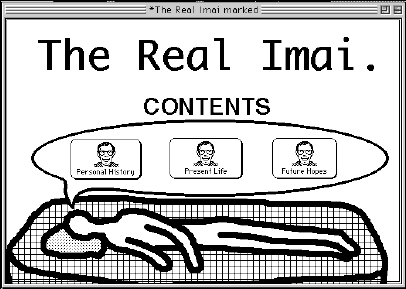
Figure 2. Sample directory card for a Real Me stack.
Sources of Motivation in a CALL Scenario
Lawrie Hunter
Kochi University of Technology
lawrie@info.kochi-tech.ac.jp
http://www.info.kochi-tech.ac.jp/lawrie/
Please quote as Hunter, L. (1998) "Sources of Motivation in a CALL Scenario" in Peterson, M. (ed.) (1998) New technology in the classroom (proceedings of the 1998 Central Japan Language Education Workshop), pp. 40-53
The entry-level English composition course taught in the CALL (computer assisted language learning) lab at Kochi University of Technology has proven to be a highly motivating experience for the students. In the interest of further development if this CALL approach, it is important to seek out the sources of this motivation.
CALL, like any other educational tool, may be seen as an environment where the learner has access to a variety of resources for the acquisition of knowledge and skills. It is the teacher's function to motivate and support the learner's use of these resources. Such motivation and support will depend on the existence of a shared focus, a shared perspective, between learner and teacher. If a CALL lab is large, how can the teacher and learner share a focus? Figure 1 is intended to give some sense of the choice that we face in CALL design. At KUT we favor the "intimate" end of the spectrum.
|
|
|
|
|
Personal basis |
Name basis |
Roll basis |
Figure 1. The spectrum of teacher-learner relationships
The instructors in the KUT CALL lab have all reported high motivation in the writing course, as evidenced by eager and persistent effort by students, proactive contributions by many students (doing more than called for, extending the scope of assigned tasks) and warm interpersonal contact that might usually be associated with smaller, communicative type courses.
The following ten elements of the writing course methodology have been identified as possible sources of the motivation described above:
1. Communication by means of demonstrations broadcast from the teacher's computer to all student monitors.2. Frequent face-to-face communication between learners and instructor.
3. Frequent task closure, frequent feedback, frequent evaluation.
4. The use of a motivating, easily mastered software (HyperCard) which allows the target student production, writing, to be embedded in an attractive hypertext medium.
5. Motivating topics which draw on the student's personal experience rather than requiring external research (focus on the task of structuring information).
6. The visual representation of writing structure in both the directory and the subsections of the electronic documents which the students create.
7. The use of structure-revealing formats in hard copy instructional materials and homework worksheets.
8. "Typing tests" with curriculum-related grammar or structure content.
9. The use of web based email (in this case hotmail) for communication and for file management by students, individually and in projects.
10. Use of the teacher's web site as a resource and as a window on the greater world.
1. Broadcast to all student monitors.
On the first day of the CALL writing course, the students are confronted with a number of possibly intimidating elements:
1. The instructor's explanations are in English.
2. The computers have an English operating system.
3. The software and menus are English-based.
KUT is in its second year of operation: having no track record of placing students in jobs upon graduation, the university has accepted entrants from a variety of backgrounds. It could be said with little exaggeration that the present student body is not generally academically oriented, and that most students have not given much attention to English in the past. Thus the all-English atmosphere of the CALL lab understandably presents a source of some anxiety to many of the students.
As an inroad to reducing student anxiety, the instructor broadcasts the contents of his computer screen to all student monitors. Carefully, with repetition of both computer moves and utterance, the instructor opens the software which the students will use, creates a new file, saves it to a floppy disk just as the students will, and begins simultaneously typing and talking, giving a dual input which brings calm to the lab. This technique of broadcasting visual input of demonstrations accompanied by closely tied teacher talk is used throughout the two writing courses. After as few as two classes, the students seem to no longer notice that the instruction is being spoken in English.
2. Frequent face-to-face communication between learners and instructor.
During the preparatory year before the opening of KUT, the author visited a number of CALL labs around Japan. Among the various considerations that appeared important in lab design, floor plan surfaced as a surprisingly important consideration. Following the lead of Professor Ozeki at Chubu University, I elected to lay the computers out in rows leading away from the instructor's control panel. This has an advantage in that the instructor can easily see the general state of all computer monitors from one end of the room. A greater advantage is the ease of physical access to each student's computer. By designing very wide aisles,
going even to the extent of making desks slightly shorter from front to back, we succeeded in making a spacious work area where students could easily meet in groups, and where instructor visits were comfortable in terms of space.
3. Frequent task closure, frequent feedback, frequent evaluation.
Project work in the CALL writing course is always divided into subtasks which are usually done in one class period. The instructor typically circulates around the student machines, offering suggestions and encouragement as the students work at creating documents and entering the text which they have written for homework into those documents. At least the homework writing is evaluated each day. Projects are usually relatively short in first quarter: this allows for frequent evaluation and reporting to the students of their cumulative assessment. Students appear to thrive in a situation where they know exactly where they stand with regard to deadlines and assessment.
4. The use of a motivating, easily mastered software (HyperCard) which allows the target student production, writing, to be embedded in an attractive hypertext medium.
HyperCard (for the Macintosh) is arguably the oldest hypermedia authoring software, yet its appeal is strong, despite the lack of color and the inferiority of pasted graphics. Small tear-off menus provide simple graphics tools, textures and fonts. Text, both as graphic and in editable text fields, may be placed on the individual pages (called cards). Buttons, which can link pages or initiate programmed operations, are easily created in a number of formats.
Simple animations, insertion of sound clips and graphic transitions from page to page are part of the HyperCard repertoire. Students can author a reasonably attractive first stack (set of navigable cards) in a couple of hours. With HyperCard tasks, the important issue for the instructor is to keep the balance of time and effort towards more writing and less graphic content; the students tend to lean towards more graphics and less writing. Windows computers cannot use HyperCard, but the software called Toolkit provides much the same functionality.
5. Motivating topics which draw on the student's personal experience rather than requiring external research (focus on the task of structuring information).
In the KUT writing team we heavily emphasize the structural aspect of writing. The students do not have sufficient background knowledge of English to be able to benefit from the full Writing Process approach. In order to keep the focus on structuring of information and avoid the distraction of information searches, we assign two major tasks which draw on the students' individual backgrounds.

Figure 2. Sample directory card for a Real Me stack.
The first assignment is "The Real Me", composed of a directory card (fig.2) and three cards which describe the student's vision of herself in the past, the present (fig. 3) and the future. This task has the obvious benefit of review three basic verb tenses, and it also forces the student to keep three subtopics physically separate, on three different cards, which is a step toward eliminating the 'tossed salad' approach which is so common Japanese student writing.
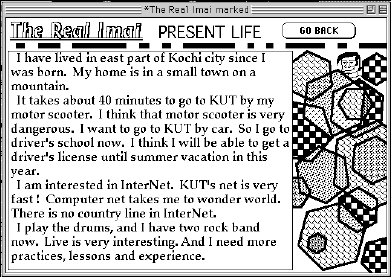
Figure 3.Sample present tense card from a Real Me stack.
6. The visual representation of writing structure in both the directory and the subsections of the electronic documents which the students create.
The physical separation of structural elements onto different cards of a HyperCard stack (mentioned in section 3) is one way in which we attempt to foster student awareness of structure in writing. Our other powerful signifier of writing structure is the directory card, the opening card of the student's HyperCard stack. On this first card, the student must somehow graphically represent the sub-document structure of the stack, and link from that graphic representation to the other cards.
David Greene (in press) of KUT English has been developing instructional material to develop the student use of graphic representation of information structure. Greene's approach is centered around LATCH, an acronym for Location, Alphabetical, Time, Category and Hierarchy, which are identified by Wurman (1996) as the five ways in which information can be represented graphically.
7. The use of structure-revealing formats in hard copy instructional materials and homework worksheets.
The KUT English CALL writing system is not paperless. Students are given packets of hard copy which contain instructional materials, task descriptions (fig.4) and examples, and tightly controlled format pages for pencil-based homework (fig 5). Considerable effort is made to keep the text sections of these materials easily accessible to the non-native reader of English. Guidelines for this kind of writing may be found in Hunter (in press).
It is interesting to note that one rule in CALL writing classes is that if the student has not done the pencil homework, the instructor will shut down the student's computer until the homework has been completed. This reveals the motivating power of the computer environment: after just a couple of classes, the incidence of students arriving without homework drops to zero, a remarkable phenomena.
8. "Typing tests" with curriculum-related grammar or structure content.
New students typically are new to typing, or have a very rudimentary hunt and peck approach to text entry. There appears to be considerable motivation to learn to touch type, perhaps resulting from a learner perception of typing as being a high-tech image skill. At any rate, the students readily and diligently prepare homework tasks which will be the content of the next class's typing test (fig. 5). These typing tests are evaluated as part of the student's portfolio and are worth enough points that few students overlook this relatively casual set of tasks.
9. The use of web based email (in this case hotmail) for communication and for file management by students, individually and in projects.
The CALL writing courses take place in two non-continuous quarters, for a total of 15 sessions per quarter. The classes are 60 minutes in duration, though instructors usually extend to 90 minutes, largely due to student demand (another indicator of high motivation).
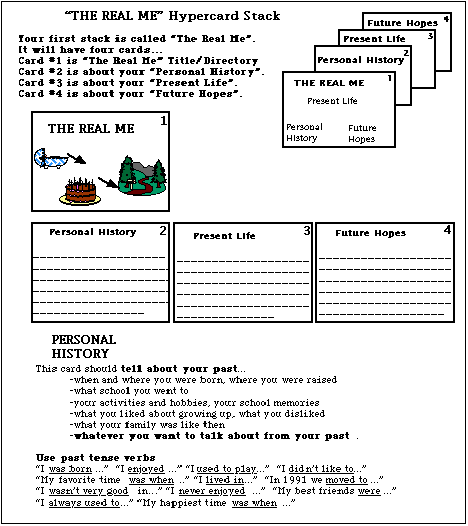
Figure 4. Sample task description sheet (Greene)
Students begin to think strategically about homework and about the amount of time required for word processing entry of the text they have created for homework. They experiment with creating files on their own computers, Fujitsu laptops, but the problem of file compatibility is defeating, as is the lab's anti-virus policy of not allowing foreign floppies in the lab. Email emerges as a resource, but the students cannot log into their campus email accounts from the lab. They
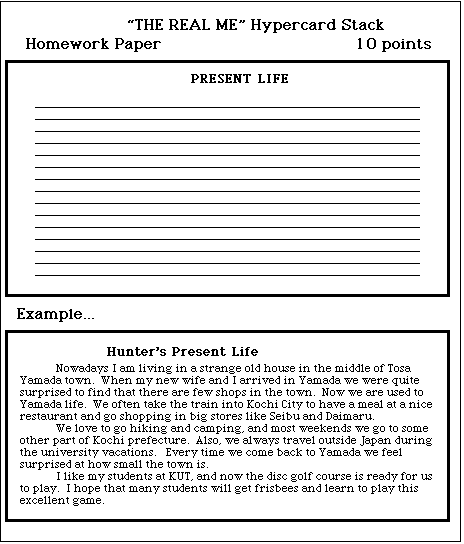
Figure 5. Sample homework sheet.
can , however, access the world wide web (www) and we have developed a pattern of having every student sign up for a free web mail account at www.hotmail.com. Not only does this facilitate students accessing their files cross-platform, but it provides interesting possibilities for group projects where the sharing of files is important.
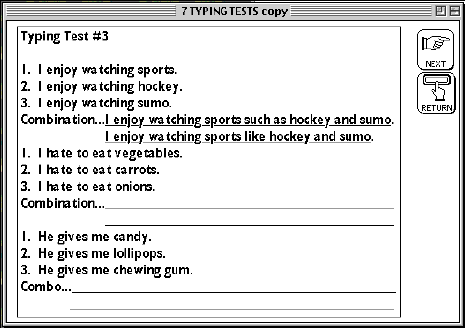
Figure 6. Sample typing test (Greene)
An example of this is the Young Nihongo Dictionary project, where each student creates definition entries for a dictionary, and these are shared amongst sizable groups of students.
The use of such text management and file management techniques also sees the students becoming more aware of the sub-tasks of writing, and of the component nature of text and graphics. Once students begin to take on this critical perspective of writing and composing, it seems that teacher input about writing strategy begins to be more relevant to the students.
Writing Process methodology (White and Arndt, 1991) strikes us in KUT English as very appropriate for the development of writing strategy, but our students' weeak English knowledge and skill make certain aspects (brainstorming and peer editing) of that technique difficult to implement. Marcus Otlowski (1998) of KUT English is now developing a HyperCard stack which supports student brainstorming and keeps writing structure in the foreground throughout the brainstorming activity.
10. Use of the teacher's web site as a resource and as a window on the greater world.
Students can access much of the course instructional material and assignment explication on the teacher's web site (http://www.info.kochi-tech.ac.jp/lawrie/).
The students appear to enjoy this form of access, given the color, the electronic 'coolness'. However, the use of hard copy instructional materials remains central the KUT CALL lab approach.
Within the teacher's web site, there are a number of web access pages which connect the students to reference sites and reading sites. This 'cultural planetarium' aspect, providing an arena where instructor and learner can look at the world together, was inspired by the Dictionary of Cultural Literacy, although that book/idea was too narrow, biased, ethnocentric, discriminatory and prescriptive for the author's purposes. The teacher's web site is popular with students and appears to be motivating.
Structural Models of CALL: an aid to deliberation
CALL instructional design involves consideration of many different parameters, from hardware to educational philosophy to classroom sociology. It is difficult to keep these parameters in mind, much less in perspective. A structural model of CALL dimensions can be a powerful organizing tool for such mental mapping. There are a number of models in recent literature, perhaps most notable being that embodied in the typology of CALL found in the appendix of Warschauer's (1996) introduction to CALL.
Dillon's (1996) TIMS (Task Model, Information Model, Manipulation skills and facilities, Standard reading processor) framework for electronic text design also suggests at a powerful approach to modelling CALL parameters, but adaptation would require much work.
The models mentioned above are structurally interesting, but would be much more powerful if they were placed in a graphic format. Given the variety of taste (or philosophy) with regard to curriculum, methodology, task and evaluation, it would appear that any given CALL designer, developer or analyst would be well advised to construct a model with a small number of parameters, those being the most relevant to the observations or decisions to be made.
For example, the author has devised a structural model of dimensions of CALL (fig. 6). This model, which has proven useful for deliberations about task, methodology and objectives, is not a prescriptive one. Rather, each instructor or team would be well served to develop a model which reflects their greatest concerns in CALL development.
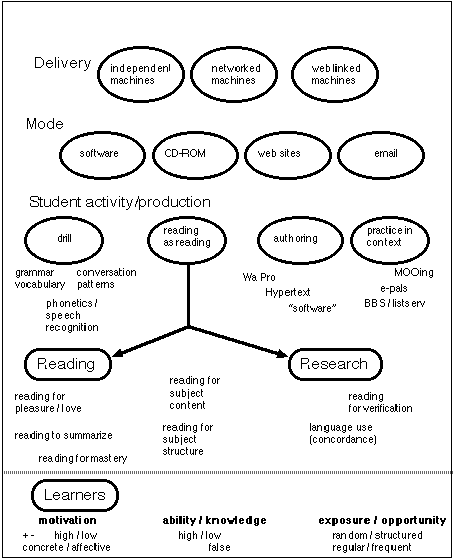
Figure 6. A structural model of CALL dimensions.
Summary
Some of the possible factors of student motivation listed above are simple pedagogical common sense; some hint at CALL-specific dynamics. The kind of reporting embodied in this paper can have benefits for both development of one's own instructional design and sharing of professional experience.
Sources
Greene, D. (in press) LATCH: Syllabus design for EFL instruction in CALL. Computer Assisted Language Learning (the journal) 26.
Dillon, A. (1996) TIMS: A framework for the design of usable electronic text. In van Oostendorp, H. and de Mul, S. (Eds.): Cognitive aspects of electronic processing (pp. 99-119). Norwood, NJ: Ablex.
Hirsch, E.D., Kett, J.F., and Trefil, J. (1993) Dictionary of cultural literacy. Boston: Houghton Mifflin.
Hunter, L. (in press) Text nouveau: Visible structure in text representation. Computer Assisted Language Learning (the journal) 26.
http://www.info.kochi-tech.ac.jp/lawrie/tnsecret.html
Murray, L. and Barnes, A.. (1998) Beyond the 'wow' factor. System 26: 249-259.
Otlowski, M. (in press) The writing process and CALL: hypermedia software for awareness of structure in writing. Computer Assisted Language Learning (the journal) 26.
Warschauer, M. (1996) Computer-assisted language learning, An introduction. In S. Fotos (Ed.), Multimedia language teaching (pp. 3-20). Tokyo: Logos International.
White, R. and Arndt, V. (1991) Process writing. Burnt Mill, Essex: Longman.
Wurman, S. (1996) Information Architects. New York: Graphis.